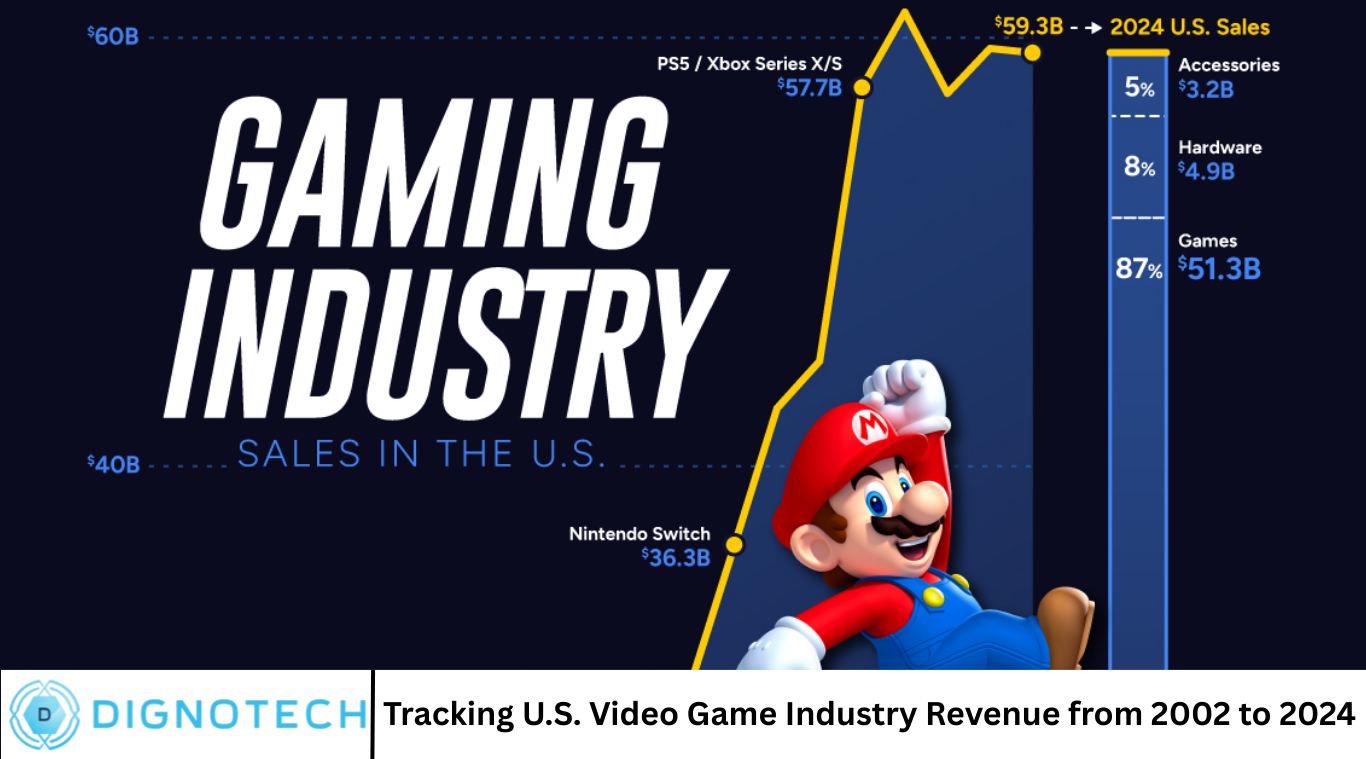Tracking U.S. Video Game Industry Revenue from 2002 to 2024

The video game industry has experienced unprecedented growth over the past two decades, evolving from a niche pastime to a mainstream form of entertainment. In the United States, this expansion has been especially pronounced, with revenues soaring from modest beginnings in the early 2000s to becoming a multi-billion-dollar industry today. This article explores the trajectory of the U.S. video game market from 2002 to 2024, highlighting the factors driving growth, shifts in consumer behavior, the impact of technology, and the future outlook.
Early 2000s: Foundations of a Growing Industry
In 2002, the U.S. video game industry was already a well-established market but far from the behemoth it is today. Revenues were predominantly driven by physical sales of console games on platforms such as Sony’s PlayStation 2, Microsoft’s Xbox, and Nintendo’s GameCube. PC gaming held a dedicated but smaller audience, while mobile gaming was still in its infancy, limited by the capabilities of early mobile devices.
At that time, video games were primarily sold in retail stores, and physical media dominated. Popular game genres included action, sports, and role-playing games (RPGs). The industry generated approximately $7 billion in revenue in 2002, marking a strong foundation for the coming years.
Mid-2000s: The Rise of New Consoles and Online Play
The mid-2000s brought a wave of innovation that significantly impacted industry revenues. The introduction of the Xbox 360 in 2005 and Sony’s PlayStation 3 in 2006 ushered in a new generation of powerful consoles. These systems offered improved graphics, online multiplayer capabilities, and access to digital stores for downloadable content.
Online gaming began to flourish with titles like “Halo 2,” which popularized competitive multiplayer modes and online communities. This era also saw the rise of digital distribution platforms like Steam for PC games, which helped expand the market beyond physical sales.
By 2008, the U.S. video game industry’s revenue had grown to roughly $15 billion, driven by increased console sales, the growing popularity of multiplayer gaming, and the initial stages of mobile gaming emergence.
Late 2000s to Early 2010s: The Mobile Revolution and Digital Shift
The launch of the iPhone in 2007 and the App Store in 2008 revolutionized the gaming landscape. Suddenly, video games were no longer confined to consoles and PCs; mobile devices became powerful gaming platforms accessible to millions.
Casual games such as “Angry Birds” and “Candy Crush” attracted a broad audience, including demographics previously less engaged with traditional gaming. This expansion brought a significant influx of new players, increasing overall revenue.
During this period, digital game sales began to outpace physical sales, and subscription services like Xbox Live Gold and PlayStation Plus introduced new revenue models. By 2012, U.S. industry revenues had reached approximately $20 billion.
Mid-2010s: Esports, Streaming, and New Monetization Models
The mid-2010s marked another leap forward as esports and game streaming became mainstream phenomena. Platforms like Twitch and YouTube Gaming allowed players to watch live gameplay, creating new communities and revenue streams.
Games like “Fortnite,” which launched in 2017, popularized the free-to-play model with in-game purchases (microtransactions) for cosmetic items and battle passes. This model proved incredibly lucrative, driving significant revenue growth without relying solely on upfront game sales.
By 2017, U.S. video game industry revenue had surged to around $35 billion, fueled by the convergence of digital sales, mobile gaming, esports, and streaming.
Late 2010s to Early 2020s: Next-Gen Consoles and Pandemic Boost
The release of Sony’s PlayStation 5 and Microsoft’s Xbox Series X and S in late 2020 marked the beginning of the next generation of gaming hardware, offering enhanced graphics, faster loading times, and new gameplay experiences.
At the same time, the COVID-19 pandemic in 2020 and 2021 led to a surge in gaming activity as people stayed home and sought entertainment. This accelerated revenue growth across all platforms: consoles, PC, and mobile.
The rise of cloud gaming services like Google Stadia and Xbox Cloud Gaming hinted at a future less dependent on hardware ownership. The industry’s total revenue in the U.S. reached approximately $60 billion by 2021.
2022-2024: Current Trends and Future Prospects
Between 2022 and 2024, the U.S. video game industry is expected to continue growing steadily. Key drivers include:
- Expansion of Mobile Gaming: Mobile continues to dominate in terms of user base and revenue, thanks to widespread smartphone adoption and innovative gameplay.
- Subscription Services: Services like Xbox Game Pass offer players access to large libraries of games for a monthly fee, attracting new consumers and stabilizing revenue.
- Virtual Reality (VR) and Augmented Reality (AR): Emerging technologies offer immersive gaming experiences, though they remain niche markets for now.
- Cross-Platform Play and Cloud Gaming: These trends break down barriers between devices, making gaming more accessible.
- Increased Investment in Game Development: Larger budgets and new studios mean more high-quality games, sustaining consumer interest.
Estimates suggest that by 2024, U.S. video game industry revenues could surpass $75 billion, reflecting a doubling of revenue in just over two decades.
Factors Driving Industry Growth
Technological Innovation
Advances in hardware and software have continually pushed the boundaries of what games can deliver, attracting a growing audience.
Changing Consumer Demographics
Gaming is no longer just for teens or young adults. The average gamer today is older, more diverse, and includes a higher percentage of women.
New Business Models
From free-to-play with microtransactions to subscription services and digital distribution, innovative models have expanded revenue streams.
Globalization and Connectivity
The internet has connected gamers worldwide, enabling multiplayer experiences, esports, and game streaming.
Cultural Acceptance
Video games are increasingly recognized as legitimate entertainment, with mainstream media coverage and celebrity involvement.
Challenges Facing the Industry
Despite impressive growth, the U.S. video game industry faces several challenges:
- Regulatory Scrutiny: Concerns over data privacy, microtransactions, and content regulation are growing.
- Supply Chain Issues: Hardware shortages can limit console availability and slow growth.
- Market Saturation: With so many games available, standing out and maintaining player engagement is increasingly difficult.
- Workforce Concerns: Issues around crunch time, diversity, and workplace culture continue to draw attention.
The Cultural Impact of Video Games
The rise in revenue reflects not only economic growth but also the deepening cultural significance of video games. Gaming now influences music, movies, fashion, and social interaction. It serves as a platform for storytelling, competition, and creativity.
The popularity of esports has turned gaming into a spectator sport, with professional players and tournaments attracting millions of fans. Social features within games foster communities and friendships worldwide.
Frequently Asked Questions
What factors contributed most to the growth of the U.S. video game industry between 2002 and 2024?
Key contributors include technological innovation, the rise of mobile gaming, digital distribution, new business models like microtransactions and subscriptions, and broader cultural acceptance.
How has mobile gaming influenced the video game market in the U.S.?
Mobile gaming dramatically expanded the player base by making games accessible on smartphones and tablets, introducing casual gamers and generating substantial revenue through app stores.
What role did the COVID-19 pandemic play in the video game industry?
The pandemic led to increased gaming activity as people sought entertainment during lockdowns, boosting sales across consoles, PC, and mobile platforms.
How important are subscription services like Xbox Game Pass for the industry?
Subscription services provide steady revenue streams, attract new customers by offering large game libraries for a flat fee, and support ongoing engagement with players.
Are physical game sales still significant in the U.S. market?
Physical sales have declined significantly, with digital sales dominating due to convenience, accessibility, and the rise of online stores.
What challenges does the video game industry currently face?
Regulatory scrutiny, supply chain issues, market saturation, and workforce concerns are among the key challenges.
What trends are expected to shape the future of the video game industry?
Growth in cloud gaming, VR/AR technologies, cross-platform play, and increased investment in high-quality content are expected to be major future trends.
Conclusion
From $7 billion in 2002 to potentially over $75 billion in 2024, the U.S. video game industry’s revenue growth is a testament to its dynamic evolution. Driven by technological advancements, shifting consumer preferences, and innovative business models, gaming has transformed into a dominant form of entertainment.As the industry continues to innovate and expand, it will play an increasingly vital role in the U.S. economy and cultural landscape, shaping how people connect, compete, and create.



